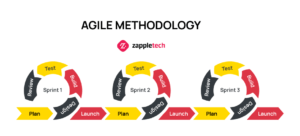Most mobile and web projects are built using an agile methodology. Thus, about 97% of organizations implement this work model. Teams submit updated applications to test new and existing functionality. Automated Testing (AT) helps in development and implementation, enhancing the stability of a digital product. Agile methods help to identify problems early, ensuring the constant interaction of multidisciplinary professionals. We will figure out why automation testing is important and what metrics and approaches are the best to use.
Understanding why test automation is important in agile is essential for any development team. Automation testing allows for continuous integration and delivery, ensuring that any code changes do not introduce new bugs or issues. By automating repetitive and time-consuming testing tasks, teams can focus on more complex problem-solving activities. Moreover, automated tests can be run frequently without additional costs, providing consistent feedback and enabling faster decision-making.
Implement test automation from the beginning of the project. Integrating automated tests early in the development cycle helps catch issues sooner, reduces maintenance costs, and ensures a smoother development process. Continuous integration of automated tests allows for rapid feedback and quick adjustments, enhancing the overall quality of the product.Mykhailo PoliarushCEO, ZappleTech Inc.
Metrics and approaches for effective automation testing in agile include tracking the number of automated test cases, their pass/fail rates, and the overall test coverage. These metrics help teams measure the effectiveness of their testing efforts and identify areas for improvement. Additionally, integrating automation testing with tools like Jenkins, Selenium, or Cypress can streamline the process, making it more efficient and reliable.
In conclusion, automation testing is a cornerstone of agile methodologies. It not only ensures the stability and quality of the product but also supports the agile principles of flexibility, quick feedback, and continuous improvement. Understanding why test automation is important in agile and implementing the best metrics and approaches can significantly enhance a team’s productivity and the overall success of the project.

Table of Contents
Testing Metrics: Assessing the Contribution of Agile Automation
Number of Bugs
Bugs to be fixed should reflect actual values. Identification of critical problems is possible during development using automatic checks. For example, the Selenium tool allows you to run tests and multiple validations simultaneously. The correlation between the number of tests and the number of bugs detected is directly proportional. It is an indicator of the correctly chosen technical stack, as well as testing techniques. This answers the question of why test automation is important in agile. The better the testing process is organized and woven into development, the better the final results of the collaboration.
By implementing automated testing, teams can significantly reduce the number of bugs that escape into production. Automation ensures that repetitive tasks are consistently executed, which enhances the accuracy of the tests and reduces the risk of human error. This is especially crucial in agile environments where rapid iterations are common. Continuous integration and continuous delivery (CI/CD) pipelines rely heavily on automation to maintain quality at speed.
Moreover, automated tests can be reused across different projects and versions, providing a scalable and cost-effective solution for quality assurance. This reuse helps maintain consistency in testing, ensuring that new changes do not introduce new bugs or break existing functionality. Automated testing tools like Selenium, JUnit, and TestNG can integrate with various development environments, further embedding testing into the agile development process.
In essence, the automation of tests supports agile practices by enabling faster feedback loops, improving code quality, and increasing the efficiency of the development team. This seamless integration of testing and development is a key reason why test automation is important in agile methodologies.
Correction factor
Development cycle duration
The duration of the development cycle is crucially dependent on the speed at which critical errors are identified and the assurance obtained for the launch of an IT product. Testing is one of the main stages in this cycle, making its automation vital for improving efficiency. By automating tests, you reduce the need for manual intervention, which decreases the number of specialists involved and shortens the project timeline.
In an agile environment, where rapid iterations and continuous delivery are key, understanding why test automation is important in agile is essential. Automated testing enables quicker feedback loops and faster bug detection, allowing development teams to address issues promptly and move swiftly to the deployment phase. The concerted actions of the participants, supported by test automation, ensure a seamless and accelerated transition to the final step of deploying the application.
Integrating automated testing into the agile workflow not only enhances productivity but also ensures that the quality of the product is maintained throughout the development process. This efficiency is pivotal in meeting tight deadlines and delivering high-quality software in a competitive market.
Maintenance cost
Maintenance cost is a critical factor in evaluating the success of automated testing (AT) following the implementation of a digital product by the customer. Post-deployment, it is essential to gather information about the system’s operation from the technical support staff. This data provides insights into how well the system performs in real-world conditions and identifies areas that need improvement.
One of the key reasons why test automation is important in agile is its ability to reduce maintenance costs. By providing testers with effective diagnostic methods, automated testing helps quickly identify and eliminate the reasons for user requests. This proactive approach minimizes the need for extensive manual troubleshooting and reduces the overall maintenance burden on the technical support team.
In an agile environment, where continuous integration and deployment are practiced, maintaining the quality of the software without escalating costs is crucial. Automated testing ensures that any changes or updates to the system do not introduce new issues, thereby keeping the maintenance costs in check. Additionally, it allows for more efficient resource allocation, as fewer specialists are needed for routine maintenance tasks, enabling the team to focus on more strategic activities that add value to the project.
Overall, integrating automated testing into the agile workflow not only enhances the quality and reliability of the product but also significantly lowers maintenance costs, making it a cost-effective solution for long-term success.
Agile methodologies thrive on teamwork and communication. Ensure that all team members, from developers to QA engineers, are involved in the testing process. Automated testing tools facilitate seamless collaboration by providing clear, consistent results that everyone can access and act upon. Regular meetings and feedback loops help keep everyone aligned and focused on delivering a high-quality product.Sergey AlmyashevCOO, ZappleTech Inc.
Speed of closing stages
The AT team determines how to increase the number of completed tasks for a particular time. Planning the next iterations and meetings using Agile techniques (Scrum, Nexus, LeSS) helps to improve the work. Automation reduces the time to complete a project.
Understanding why test automation is important in agile is essential to grasping its impact on the speed of closing stages. Automation streamlines the testing process, reducing the time required to identify and fix issues. This acceleration is particularly valuable in Agile environments, where rapid development cycles and continuous delivery are the norms. With automated testing, teams can quickly verify the functionality of new features, ensuring that each iteration is completed faster and with fewer errors.
Moreover, automation facilitates better resource management, allowing team members to focus on more complex tasks rather than repetitive testing activities. This shift not only speeds up the overall project completion but also improves the quality of the output by ensuring that critical issues are addressed promptly.
Incorporating automated testing into Agile methodologies helps teams close stages more efficiently, ultimately leading to a quicker project turnaround. This efficiency is vital in maintaining a competitive edge in the fast-paced digital landscape, where the ability to deliver high-quality products swiftly can make a significant difference.
By reducing the manual effort and enhancing the accuracy of tests, automation ensures that each stage of the project is completed on time, contributing to the overall success and timely delivery of the digital product.

AT methodologies for agile projects
AT methodologies for agile projects are designed to ensure efficient and effective testing processes. As a rule, development is based on tests generated for the customer, with IT experts utilizing regression AT to gain more time to explore a digital product and conduct other types of validation. This is another reason why test automation is important in agile environments.
The earlier and better the software testing process is organized, environments are deployed, and parallelization is set up, the faster teams get results. Automated testing methodologies in Agile projects, such as behavior-driven development (BDD) and test-driven development (TDD), emphasize early and continuous testing. These practices allow teams to identify and address issues as soon as they arise, significantly improving the quality and reliability of the software.
The number and quality of bugs detected during a single testing cycle and development sprint depend directly on the methods chosen to work on the product. Efficient methodologies ensure that critical bugs are identified and resolved early, reducing the risk of major issues during the release phase. On the other hand, if the methodologies are inefficient, the results will be unsatisfactory: unimportant bugs may be found while critical bugs are missed. Ultimately, this will lead to problems with the release version, resulting in additional support and optimization costs.
In agile projects, employing robust AT methodologies enables teams to maintain high standards of quality while keeping pace with rapid development cycles. Automated tests can be executed repeatedly with minimal effort, providing quick feedback and ensuring that new code changes do not introduce new issues. This continuous feedback loop is crucial for agile teams aiming to deliver high-quality software consistently and efficiently.
By incorporating automated testing methodologies into Agile workflows, teams can ensure a smoother and more reliable development process, minimizing risks and optimizing resource allocation. This approach not only enhances the overall quality of the product but also reduces the time and cost associated with post-release support and maintenance.
Let’s take a look at techniques that define and simplify testing tasks:
- TDD — Organizing short development cycles by unit, integration, and functional tests. They form the requirements before compiling the source code. Successful passing of the test allows the developer to move to the stage of improvements and fixes and provide testing for bugs periodically.
- ATDD — Verifying a digital product after development and implementation. Initially, the criteria for the correct execution of the work must be formed. Testing is carried out to verify that the application meets the needs and requests of the user.
- BDD — a description of user actions by testers in behavior language. The developers provide the ability to turn such texts into tests. It is followed by the usual AT stages and the product launch.
The successful use of such approaches in a team depends on the qualifications and initiative of the participants. The main goal is the quality of the developed product, not the speed of work.
How Developers and Testers work together
The ideal agile project involves a discussion of the digital product and built-in functionality before starting the main work. The team must understand the technological value of the resulting IT platform and its user-friendliness. Testers are customers of automated test developers. They can contact the team leader to resolve the crucial product issues quickly.
During the product deployment phase, an agile approach allows IT to be more quickly informed about the current state of a digital project. Test cases require regular and repeated checks with accurate results to provide feedback. Creating new functionality should be carried out simultaneously with the testing of individual elements. Agile methodologies help coordinate the work of project team members by scheduling their meetings.
Even close coordination of processes is sometimes ineffective in the collaborative routine of developers and testers. The main problem with this is a poor technical stack. That is, the QA team, focusing only on achieving results, may choose convenient but inefficient tools, reducing the relevance of the data obtained or complicating the process of decoding reports. This negatively affects the quality of performance of direct duties and reduces the validity of tests.
Why test automation is important in Agile: 5 key reasons
Agile approaches are used to develop digital products and accelerate their release to the market. Changes and updates are essential elements of agile models. AT can quickly correct detected errors, ensuring the technological value of the product for the user. In Agile development, it guarantees good performance, reliability, reuse, and more. Let’s highlight 5 main features that will make it clear why test automation is so important.
1. Improving Teamwork
Improving teamwork is one of the key benefits of adopting agile methodologies, and it highlights why test automation is important in agile environments. Agile methods facilitate detailed planning, breaking the project into short, manageable chunks, and tracking results efficiently. This approach not only streamlines the workflow but also fosters a collaborative environment where employees’ career ambitions are nurtured, allowing everyone to shine during decision-making stages.
Agile frameworks, such as Scrum and Kanban, offer a system of self-organized teams. These teams are empowered to make decisions collectively, encouraging a sense of ownership and responsibility among all members. This self-organization is crucial for maintaining high motivation and engagement levels, as team members feel their contributions are valued and impactful.
Automation technologies play a significant role in enhancing teamwork under these frameworks. During testing, automation allows for coordinated cooperation and full interaction among multidisciplinary specialists. By automating repetitive and time-consuming tasks, team members can focus on more critical and creative aspects of the project, leveraging their unique skills and expertise. This not only boosts productivity but also promotes a culture of continuous improvement and learning.
The integration of automated testing in agile workflows ensures that the testing process is seamless and efficient, facilitating real-time communication and collaboration among team members. Automated tests provide quick feedback on code changes, enabling developers, testers, and other stakeholders to work together closely to identify and resolve issues promptly. This collaborative approach minimizes bottlenecks and accelerates the overall development process.
Furthermore, automated testing tools often include features for tracking and reporting, which enhance transparency and accountability within the team. These tools allow team members to monitor progress, identify potential issues early, and make informed decisions, fostering a sense of shared responsibility and collective achievement.
In summary, by improving teamwork, agile methodologies and test automation together create a dynamic and collaborative environment where multidisciplinary teams can thrive. This synergy not only leads to higher-quality products but also to more satisfied and motivated team members, ultimately driving the success of the project.
2. Conducting Test Cases Iteration
Conducting test cases iteration is a fundamental aspect of agile methodologies, and it underscores why test automation is important in agile environments. Using automated testing (AT) tools and the correct methodology, build execution can occur daily. This frequent execution ensures that the software remains robust and reliable throughout the development process.
The results of automated checks are critical as they should guarantee that there are no maintenance problems. Automated testing tools provide consistent and repeatable test cases, allowing for thorough validation of the software at each iteration. This consistency is vital for maintaining the integrity of the product and preventing regression issues.
In agile development, the process is continuously linked to the ongoing analysis of the digital product. All agile team members are responsible for testing, making it a collective effort rather than a task confined to a specific group. This collective responsibility ensures that testing is integrated into every phase of the development cycle, from planning to deployment.
The selected frameworks in agile methodologies help to distribute time and responsibilities effectively among team members. By clearly defining roles and tasks, these frameworks ensure that everyone knows their responsibilities and can contribute to the testing process efficiently. This distribution of responsibilities is crucial for maintaining high productivity and ensuring that all aspects of the software are tested thoroughly.
Automated testing tools facilitate the rapid execution of test cases, allowing teams to identify and address issues quickly. This rapid feedback loop is essential in an agile environment, where the goal is to deliver high-quality software in short development cycles. By automating repetitive and time-consuming testing tasks, team members can focus on more complex and strategic activities, further enhancing the quality of the product.
Moreover, automated testing enables parallel testing, where multiple test cases can be executed simultaneously. This capability significantly reduces the time required for testing, enabling faster iterations and quicker delivery of new features. The ability to conduct test cases iteration efficiently is a key reason why test automation is important in agile, as it ensures that the software is continuously validated and improved.
3. Speeding up the organization of tests.
Speeding up the organization of tests is crucial in agile methodologies, highlighting why test automation is important in agile environments. The QA engineering team can prioritize and implement tasks more effectively by choosing automated testing (AT). Special tools like Testim and Selenium enable the detection of errors without the interference of the human factor, ensuring more accurate and reliable test results.
Agile practices promote close collaboration between diverse IT professionals, fostering an environment where communication and teamwork are key. This collaborative approach is essential for quickly organizing and executing tests. With automated testing, teams can create and run tests more rapidly, allowing for immediate feedback and quicker iterations.
Automated testing tools not only streamline the testing process but also help in maintaining a consistent and comprehensive test coverage. These tools can execute thousands of test cases in a fraction of the time it would take manually, ensuring that the software is thoroughly tested at every stage of development. This capability is particularly important in agile environments, where continuous integration and delivery are standard practices.
Teams can speed up the organization of tests by leveraging written code and a solid test base to build software. Automated tests can be reused across different stages of the development cycle, reducing the need for creating new tests from scratch. This reuse of test cases saves time and resources, allowing the QA team to focus on more critical tasks.
Moreover, automated testing facilitates the rapid execution of regression tests, ensuring that new code changes do not introduce new bugs. This continuous validation is essential for maintaining the quality and stability of the software, especially in agile projects where changes are frequent and incremental.
Automated testing also supports parallel testing, where multiple test cases can be executed simultaneously across different environments. This parallelization significantly reduces the overall testing time, enabling faster feedback and quicker resolution of issues. As a result, the development team can move forward with confidence, knowing that the software is robust and reliable.
Choose automated testing tools that fit your project’s needs and integrate well with your agile workflow. Tools like Selenium, Testim, and others can significantly speed up the testing process and improve accuracy. Investing in the right tools not only enhances testing efficiency but also enables your team to focus on more complex and creative aspects of the project, ultimately delivering a superior product to your users.Mikhail BodnarchukCDO, ZappleTech Inc.
4. Moving to an early stage of the project
In agile development, moving the testing process to an early stage of the project is essential for ensuring quality and efficiency. This approach underscores why test automation is important in agile environments. DevOps enables automation technologies to be introduced right from the coding phase, shifting the verification phase to the initial steps of developing a digital product. This includes forming project requirements with the customer, which is crucial for aligning expectations and setting a clear roadmap.
By integrating test automation early in the development process, teams can detect and address issues before they become more complex and costly to fix. This early intervention helps to avoid high maintenance costs and prevents hasty final bug fixes that can compromise the quality of the product. Automated testing tools, such as Testim and Selenium, allow for continuous testing throughout the development lifecycle, providing immediate feedback and enabling teams to make necessary adjustments in real-time.
An agile team can measure progress more accurately after completing each stage, thanks to the consistent and reliable data provided by automated tests. This accurate measurement is vital for maintaining the project’s momentum and ensuring that each iteration meets the required standards. It also allows for better resource allocation and more informed decision-making, as the team can identify and focus on the most critical issues at each stage.
Moreover, involving customers in the early stages of the project through clear communication and requirement formation ensures that the final product aligns with their needs and expectations. Customers will receive a digital product that has passed all validation stages, ensuring high quality and reliability. This customer-centric approach not only enhances satisfaction but also builds trust and fosters long-term relationships.
Automated testing in the early stages also facilitates the creation of a solid test base that can be reused throughout the project. This reuse of test cases saves time and resources, allowing the team to focus on developing new features and enhancements. Additionally, automated tests can be integrated into continuous integration/continuous deployment (CI/CD) pipelines, further streamlining the development process and reducing the time to market.
5. User Experience Research
User experience research is a vital component of the development process, especially in agile environments. Understanding why test automation is important in agile helps highlight how it can enhance user experience. Releasing a web or mobile application on time requires a clear deadline to calculate the development time accurately. Accelerated testing is possible with special tools that detect critical problems early, ensuring that the application meets user expectations.
Test automation tools like Testim, Selenium, and others play a significant role in this process. These tools enable the rapid execution of comprehensive test cases, identifying usability issues and other critical problems that might affect the user experience. By detecting and addressing these issues early, teams can ensure that the final product is user-friendly and functional.
Generating successful audit reports is another essential aspect of user experience research. Automated testing helps create detailed reports that provide insights into the application’s performance, usability, and functionality. These reports are crucial for validating that the application meets all the necessary requirements and provides the intended user experience. They also serve as a guarantee that the user will receive a high-quality product with the necessary functionality.
Meetings in agile frameworks like Scrum, Kanban, or Nexus are instrumental in gathering feedback and making adjustments to the product. These regular meetings facilitate close collaboration between team members and stakeholders, ensuring that everyone is aligned with the project goals. By incorporating feedback from user experience research, teams can make informed decisions and prioritize tasks that enhance the user experience.
Furthermore, automated testing allows for continuous feedback and iterative improvements. As new features are developed and integrated into the application, automated tests can quickly verify their impact on the overall user experience. This continuous validation helps maintain a high standard of quality and ensures that any changes or additions enhance the user experience rather than detract from it.

Potential Agile Automation Issues
Automation is not always a cure-all for QA masters. Despite the fact that it speeds up the process, it often leads to such problems as:
- Skipping a large number of bugs.
- Need to retune the code.
- Irrelevance of the results.
- Reduced speed of testing and development.
- Errors in the work of scripts.
Why test automation is important in agile, according to experts? It’s simple: this methodology is really effective with the right approach. If you combine automation, manual QA, and development in a single tandem, the results will be not only relevant but also of high quality.
Development based on integration and continuous validation can cause several complications with AT:
- Poor product performance. A large number of functions and extensive code can complicate the application, affecting its performance. AT tools will help you find bottlenecks in product performance.
- Frequent crashes in the code. Continuous integration and product launch require continuous AT. Code changes in Agile development cause broken code. CI/CD pipelines can help with this situation.
- Selective testing. Sprints in Agile projects can be miscalculated, leaving time to test only part of the new features. User stories are analyzed partially, which does not guarantee the quality of the technological solution. Regression AT will speed up the testing of old functions.
Automation allows you to update every element of the system within a limited time. The established sprint gives Agile teams an understanding of the time needed for each project stage. New approaches push companies to create perfect opportunities to develop new digital solutions.
So why is test automation so important in Agile development? AT will help ensure continuous testing and accelerate teamwork. Try this methodology by following the latest trends and innovations in Agile projects.
Let’s Summarize
Automation, like manual tests, is an integral component of the complex development process. Its effectiveness has been proven in practice by the experience of industry leaders such as Zapple Tech. Competently written and timely edited test scenarios deployed in a suitable testing environment save up to 90% of the time to re-examine questionable results.
Collaboration with developers further optimizes the QA process, allowing all project participants to quickly coordinate their actions and make timely changes to the code. Accordingly, it has a qualitative effect on the final development results. The final version of the software turns out practically perfect. This also affects the economic component, reducing the cost and time spent optimizing bugs.
If you want to maximize the potential of QA and Agile methodology, implement it in the development process promptly, that is, before you start working on the project directly. When choosing contractors, be guided by their experience and feedback on the team. For example, if you cooperate with Zapple Tech, you get not only a fast and expert approach to the case but also the highest quality results at quite reasonable prices.







